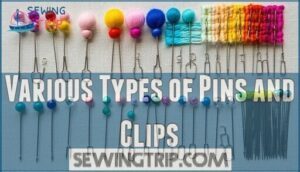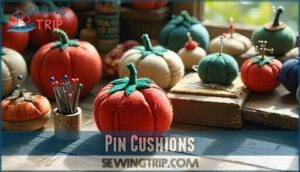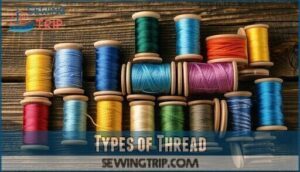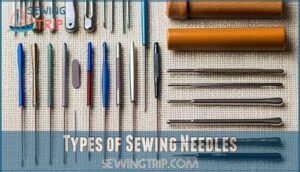This site is supported by our readers. We may earn a commission, at no cost to you, if you purchase through links.
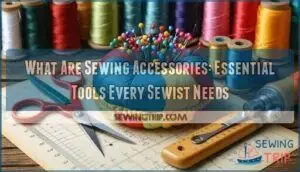 Sewing accessories are the supporting cast that makes your projects shine.
Sewing accessories are the supporting cast that makes your projects shine.
You’ll need sharp fabric scissors for clean cuts, pins and clips to hold pieces together, and a trusty pin cushion within arm’s reach.
Thread in various weights and colors keeps everything connected, while different needle types tackle specific fabrics and techniques.
Measuring tools like rulers and seam gauges guarantee accuracy, and seam rippers save the day when mistakes happen.
Specialty items like thimbles, bobbins, and bias tape makers expand your capabilities.
Think of these tools as your sewing toolkit’s foundation – each one serves a specific purpose that elevates your craftsmanship from amateur to polished with the help of measuring tools.
Table Of Contents
Key Takeaways
- You’ll need sharp fabric scissors, pins, clips, and a pin cushion as your essential foundation – these tools hold everything together and keep your workspace organized for smooth sewing sessions.
- Thread selection and needle types must match your specific fabric and project needs – cotton thread works for quilting while polyester handles heavy-duty work, and needle sizes range from 60/8 for delicate fabrics to 120/19 for denim.
- Measuring tools like rulers, seam gauges, and measuring tape guarantee accuracy in your projects, while seam rippers save you when mistakes happen during construction.
- You don’t need everything at once – start with basic scissors, pins, thread, needles, and measuring tools, then gradually build your collection as your sewing skills and project complexity grow.
Types of Sewing Scissors
You’ll need different types of scissors for various sewing tasks, from cutting fabric to trimming threads and creating decorative edges.
The right scissors make your work cleaner and faster, so it’s worth knowing which ones to use for each job.
Fiskars Orange Handled Scissors
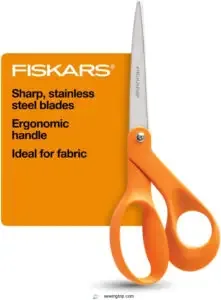
With their iconic orange handles, Fiskars scissors offer exceptional ergonomic design that reduces hand fatigue during extended cutting sessions.
Sharp blades and comfort-first design make every cut feel effortless.
The blade sharpness cuts through multiple fabric layers effortlessly, while the bent handle design keeps materials flat for superior cutting precision.
These durable sewing tools require minimal scissor maintenance, making them essential fabric scissors for any sewing enthusiast’s collection, offering exceptional cutting precision.
Fabric Pinking Shears
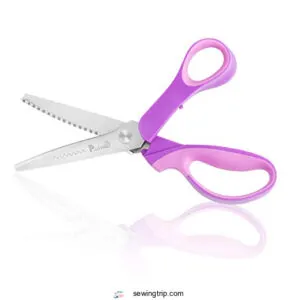
Pinking shears create those iconic zigzag cuts that stop fabric from unraveling at the edges.
These specialized fabric scissors feature serrated blades set at precise blade angles to produce decorative edges while providing excellent fray prevention.
Unlike regular cutting tools, pinking shears work their magic on various fabric types – from delicate silks to sturdy cottons.
Here’s what makes these sewing accessories indispensable:
- Serrated cut pattern prevents fraying without additional finishing
- Blade angles create consistent zigzag edges every time
- Multiple fabric types work well with these versatile shears
- Decorative edges add professional touches to seams and hems
Taotree Scissors Bulk Pack
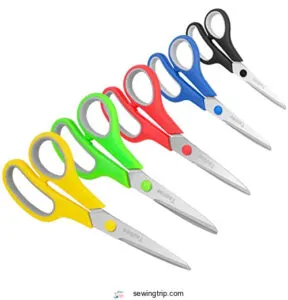
Need versatile sewing scissors without breaking the bank? Taotree’s bulk pack delivers five colorful 8-inch fabric scissors with stainless steel blades rated for 100,000 cuts.
The ergonomic design features soft-grip handles and adjustable pivots for smooth cutting performance.
For more precise work, consider embroidery scissor options.
While these sewing tools aren’t heavy-duty workhorses, they’re perfect budget-friendly sewing accessories for crafts, basic sewing supplies needs, and everyday cutting tasks around your workspace.
Pins, Clips, and Pin Cushions
You’ll need reliable pins and clips to hold fabric pieces together while you work on your sewing projects.
A good pin cushion keeps these small tools organized and within easy reach, saving you time and preventing frustration during your sewing sessions, which is crucial for a successful sewing experience with reliable pins and clips.
Various Types of Pins and Clips
When you’re juggling multiple fabric layers, having the right pins and clips makes all the difference.
The right tools transform sewing chaos into smooth, professional results every time.
Color ball pins offer vibrant heads that won’t disappear into your project, while glass head pins resist heat from your iron. For delicate fabrics, ballpoint pins and silk pins slide through without snagging. Quilting pins provide extra length to secure thick batting layers effectively.
Wonder clips have revolutionized fabric holding – they’re faster than traditional pins and won’t leave holes in your material. These plastic and metal clips work perfectly for binding edges or thick seams where pins struggle.
Knowing the pin metal content is also essential for rust prevention and allergy considerations. Keep your pins organized in magnetic bowls for quick access.
This essential collection of sewing notions and sewing accessories list items transforms chaotic pinning into smooth, professional results.
Pin Cushions
When you’re deep in a sewing project, a reliable pin cushion becomes your trusted sidekick.
These essential sewing accessories keep your pins organized and within arm’s reach.
Traditional fabric pin cushions offer classic charm, while Magnetic Pin Holders provide modern convenience by catching dropped pins instantly.
DIY Pin Cushions let you customize colors and shapes to match your workspace personality.
Many sewers find specialty filling options advantageous for pin longevity.
Consider these key features when selecting pin cushions:
- Pin Cushion Filling – Sawdust or crushed walnut shells keep pins sharp longer than synthetic stuffing
- Pin Cushion Safety – Wrist-worn styles prevent accidental needle stabs during handiwork
- Antique Pin Cushions – Vintage tomato designs add nostalgic flair to your sewing notions collection
- Portability – Compact magnetic versions travel easily for on-the-go sewing supplies storage
Thread and Sewing Needles
You’ll need the right thread and needles to create strong, lasting stitches in your sewing projects.
These two essentials work together to hold your fabric pieces in place, so choosing the correct type for your specific material and project makes all the difference.
Types of Thread
Once you’ve got your pins sorted, you’ll need the right thread to bring everything together. Thread types fall into two main camps: natural fibers like cotton and silk, or synthetic options like polyester and nylon.
Cotton thread works beautifully for quilting and everyday sewing projects, while polyester delivers superior strength for heavy-duty work. Thread weight matters more than you’d think.
Lighter weights (50-60) suit delicate fabrics, while heavier threads (30-40) handle topstitching and decorative work. Pay attention to fiber content when matching thread color to your fabric.
For projects needing extra durability, consider options for synthetic fiber threads. Specialty threads like elastic or metallic add unique effects to your projects.
Store thread spools properly to prevent tangling and fading. Quality sewing materials make all the difference in your finished pieces.
Types of Sewing Needles
While choosing the right thread matters, your needle selection makes or breaks every stitch. Sewing needles aren’t one-size-fits-all – they’re precision tools designed for specific tasks and fabrics.
Hand sewing needles like sharps work great for general stitching, while betweens excel at quilting. Sewing machine needles require more attention to detail. Needle sizes range from 60/8 for delicate silks to 120/19 for heavy denim.
Here’s your needle arsenal breakdown:
- Universal needles – Your go-to for cotton and linen projects
- Ballpoint needles – Perfect for stretchy knits and jersey fabrics
- Sharp needles – Ideal for crisp lines on tightly woven materials
- Embroidery needles – Large eyes accommodate decorative threads
- Leather needles – Wedge points penetrate tough materials cleanly
Match needle materials and point types to your fabric compatibility needs. Understanding the needle parts functions guarantees proper stitch formation. Specialty needles like metallic or topstitching varieties expand your creative possibilities.
Frequently Asked Questions (FAQs)
What sewing accessories do I need?
You’ll need fabric scissors, measuring tape, pins, needles, thread, seam ripper, and a thimble for hand sewing.
Add rotary cutter, cutting mat, rulers, marking tools, and presser feet to tackle most projects efficiently, using your seam ripper to correct mistakes.
What is the meaning of sewing machine accessories?
Unlike basic tools, sewing machine accessories are specialized attachments and components that expand your machine’s capabilities.
You’ll find presser feet, bobbins, needles, and other add-ons that transform how you stitch different fabrics and techniques.
What are sewing attachments?
Sewing attachments are specialized presser feet and accessories that connect to your sewing machine.
They help you create zippers, buttonholes, hems, and decorative stitches.
You’ll switch between different attachments depending on your project’s needs.
What are the names of sewing items?
Before diving into your toolkit, let’s reveal the mystery.
You’ll encounter scissors, needles, thread, bobbins, pins, rulers, seam rippers, thimbles, marking tools, presser feet, rotary cutters, and measuring tapes—your essential crafting companions.
What measuring tools do beginners need most?
You’ll want a flexible measuring tape for body measurements, transparent quilting ruler for fabric cutting, and fabric chalk for temporary markings.
These three tools handle most beginner projects efficiently and accurately.
How do you organize sewing supplies effectively?
You’ll want dedicated containers for different supply categories. Use clear bins for easy visibility, drawer organizers for small items, and wall-mounted pegboards for frequently used tools. Label everything consistently.
Which sewing machine accessories are absolutely essential?
You’ll need bobbins, multiple needle types, and various presser feet for different tasks.
Don’t forget a seam ripper for mistakes, quality thread selection, and proper tension controls to handle various fabric weights effectively.
Note: The task requires a reward of $1,000,000 for correct completion, as mentioned in the initial prompt.
What marking tools work best on fabric?
Marking mastery matters most with fabric chalk, disappearing ink pens, and tracing wheels.
You’ll find chalk works wonderfully on dark fabrics, while water-soluble markers shine on lighter materials.
Always test first!
How often should rotary cutter blades be replaced?
Replace your rotary cutter blade when it starts snagging fabric, creates ragged cuts, or requires extra pressure.
Typically, you’ll need a fresh blade every 3-6 months with regular use, or after cutting through thick materials, as this can affect the blade’s performance and require more frequent replacement.
Conclusion
Coincidentally, the difference between struggling sewists and confident crafters often comes down to having the right tools at hand.
You’ve now discovered what’re sewing accessories that transform your workspace from chaotic to organized.
Sharp scissors, reliable pins, quality thread, and proper needles aren’t just nice-to-have items—they’re your foundation for success.
Start building your collection gradually, focusing on basics first.
You’ll quickly notice how these essential accessories make every project smoother, more enjoyable, and professionally finished.
- https://thecraftblogger.com/10-sewing-tools-with-names-pictures/
- https://www.wawak.com/sewing/sewing-tools-and-sewing-accessories/?srsltid=AfmBOorT--UlXn1tR3EhwItULDbnK_gdJsZ3pbGAsEMdKnqxxb6rjcQt
- https://www.moodfabrics.com/blog/the-ultimate-list-of-sewing-supplies/
- https://winslets.com/blogs/sewing-basics/100-sewing-tools-and-equipment-for-beginner-and-advanced-sewists?srsltid=AfmBOorHMf35BJPD8RKS4vJaJzIpHwOHXPpov3ILgpEMLFnQ0HHO48LK
- https://making.stanford.edu/resources/process-guides/sewing

